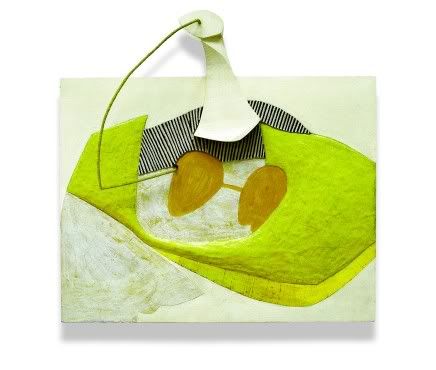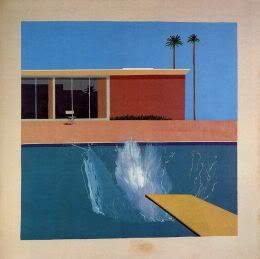
Eva Hesse, H+H
Oranges and Sardines, simply put, is the product of a combined effort by six contemporary artists to showcase their thoughts and impressions of the art-making process, and provide some insight into how contemporary abstract artists in this day and age approach their medium. In the exhibition, this goal is achieved by juxtaposing one or two of each artist’s recent works with a number of previous works by other artists who have had a great impact on them. While the exhibition boasts one unifying theme – conversations on abstract painting – the works on display span a plethora of styles and philosophies, as one might expect from a group exhibition of this magnitude. Each artist brings to the table differing voices and perspectives, running the slight risk of transforming Oranges and Sardines from a subtle conversation into a full-blown group debate.
Because of this relative lack of unity across artists, I have chosen to analyze two works, both chosen by Mary Heilmann to be included in her section of the exhibition. While Heilmann’s art is surprisingly simple in form and Mondrian-esque, the pieces that influenced her in her career are much more varied. One particular work of interest is Bruce Nauman’s Untitled (1965), the only sculpture chosen by Heilmann. It consists of a metal “pipe” extending from the wall of the gallery, forming a downward parabola and ending as a horizontal bar on the floor. While it is certainly not the most stunning of visual spectacles, it pulls the viewer in, extending through the traditional “frame” in the gallery and into the viewer’s personal space. This is consistent with the post-structuralist mentality that was made popular in the 1960s, questioning the validity and neutrality of the frame in art production. Not only is Nauman challenging the physical frame of the work by invading the viewer’s space, but he could also be thought of as pushing the boundaries of the institutional frame – in this case the frame of the art gallery – as well. The sculpture conveys the impression of being a very industrial work, seemingly pre-fabricated and lacking something in the way of artistry. If one were to look at it out of context, it could very well be a machine part, or a broken portion of a bent staircase banister. This could be taken as an “institutional critique”: a re-framing of the art world’s assumptions about the institution of the art gallery and its supposed neutrality, in the vein of Robert Smithson’s A Non-site. Who is to say what is art and what is not? Traditionally, the strict rules of the art gallery might dismiss a work of this nature, but not in Nauman’s dialectic.

David Hockney, A Bigger Splash
A second work that also seems to hold some post-structuralist sentiments is A Bigger Splash by David Hockney (1967). If Nauman’s Untitled was an open tribute to post-structuralism, this piece is a subtle nod to it, with tongue firmly placed in cheek. The subversive element in this case lies not in the painting’s form or subject matter, but in how it was made. The painting depicts a swimming pool that someone has supposedly just jumped into, making a huge, attention-grabbing splash in the bottom half of the scene. The splash of water was “painted” onto the canvas by blowing paint through a little tube typically used for putting fixative on a drawing. Hockney was effectively painting the splash by actually making a splash, something that contradicted the classical representational nature of painting. In this way, Hockney seems to be critiquing – and, in the process, breaking – the rigid rules imposed by a previous generation of painters. Also, by using a technique as transparent as this, he is re-framing the artistic process and possibly mocking it as an institution; the overall impression one gets from this work is one of spontaneity and throwing caution to the wind, overriding obsolete rules in the face of innovation.
It is not difficult to understand why these two works have been included in Heilmann’s selection of significant influences to her development as a contemporary abstract artist. Both Kaufman’s Untitled and Hockney’s A Bigger Splash challenge one’s preconceptions of art, engrained as they are in the institutional mechanisms of the art world. Each piece is subversive and bold in its own way, and speaks to the viewer outside of its so-called “frame”. The opinions and perspectives each work brings to this exhibition – this amalgamation of conversations on abstract painting – are of no small value.
Sources
Foster, Hal, Krauss, Rosalind, Bois, Yve-Alain, and Buchloh, Benjamin H.D. Art Since 1900. New York: Thames and Hudson, 2007.

No comments:
Post a Comment